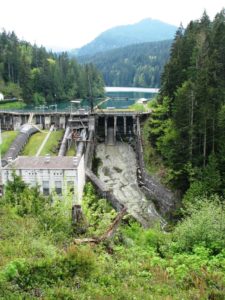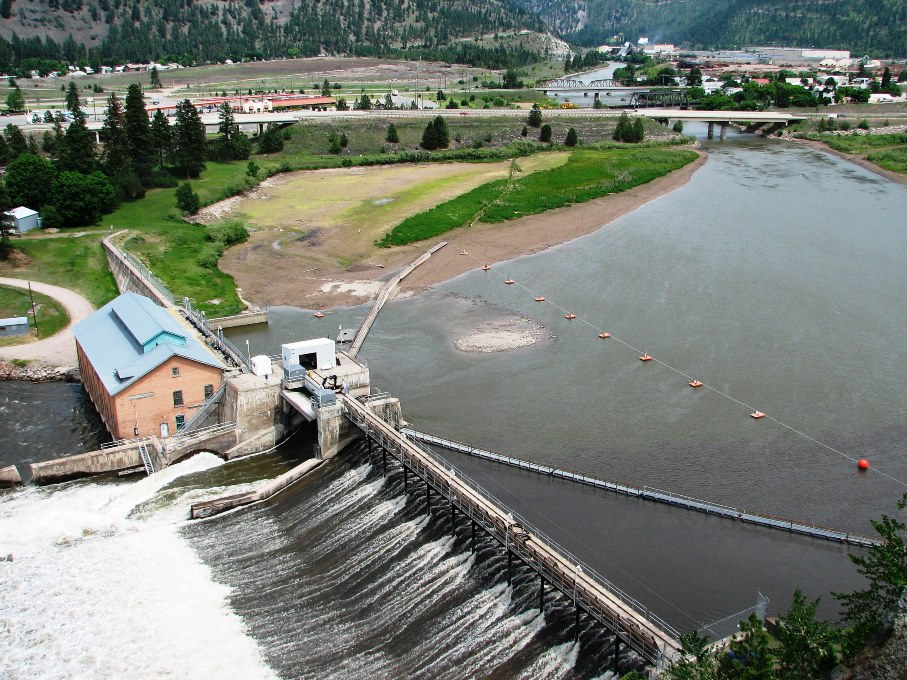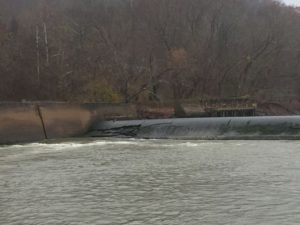For some 200 years, the U.S. Army Corps of engineers built tens of thousands of dams across America. A few of them served valid purposes, providing needed power to an industrializing nation and its cities.
But during the 20th century, the vast majority of dams built by the Corps were a by-product of the military’s then-common “use it or lose it” budgeting process. If they didn’t spend there entire budget, the unused portion was deducted from subsequent budgets.

Elwha River dam prior to removal. Photo by Storm Cunningham while in Port Angeles, WA to keynote river restoration science symposium.
As was first pointed in in the 2002 book, The Restoration Economy, the Corps greatest growth opportunity in the present and coming centuries, will be in undoing the damage of the previous two centuries.
But the problem isn’t just dams that never had a legitimate purpose: the vast majority of dams that did originally have a legitimate use are now useless, and even dangerous.
Some no longer function properly due to sedimentation. Others have deterirated over time, and pose a threat to downstream communities. No matter how well a city plans to be more resilient, a weak upstream dam can render their best efforts for naught. [Preceding text by Storm Cunningham.]
For instance, demolition of a dangerous, aging dam on the Green River near Brownsville, Kentucky is scheduled to begin the last week of March, 2017. Besides freeing downstream communities of worry about their safety, removals offers hope for the restoration of endangered freshwater mussels, as well as an improved water recreation industry in and near Mammoth Cave National Park.
The dam has been useless for over half a century, but only now are we getting around to removing it, and putting an end to its ongoing ecological damage. The lock and dam, built in 1904, closed to boating traffic about 65 years ago. Congress approved the removal of the dam in December.
Bill Zawiski is Ohio’s water quality man, and he knows the most efficient way to clean the infamously dirty Cuyahoga River that flows through Cleveland and other Ohio cities. It’s not a new regulation or cutting-edge infrastructure. The answer: tearing down old infrastructure — specifically, dams.
“If you are looking at the most economical way to gain watershed restoration, dam removal on its own jumps ahead of many things on the list,” says Zawiski, water quality supervisor with the Ohio Environmental Protection Agency.
Zawiski explains the science simply. Dams prevent waterways from cleaning themselves. When they are removed, the natural filtering process can work its magic.
“In a perfect world, we’d love to take all of the dams out,” says George Zonders, spokesman for the utilities department in Columbus, Ohio.
Kate Dempsey is the state director for the Nature Conservancy in Maine. She hopes that the dam removal trend can outlive the current political moment. “We saw that when we removed the dams from the Penobscot River, people living in the area developed a pride in where they lived, they celebrated the different ways fish moved as part of the natural state, and they wanted to come down to the river instead of ignoring it,” Dempsey says.
With the current anti-science administration in Washington, DC apparently determined to give the United States an environmental lobotomy, Dempsey says it’s too soon to know how the EPA will fare, but that the nation must remember Ohio’s Cuyahoga River, and the fire that rose out of it in 1969, inspiring the Nixon administration’s Clean Water Act.
“But free-flowing and cleaner rivers are now possible,” she says, “and that, we have to build on.”
Feature photo of Milltown Dam by Storm Cunningham. The dam was removed during the Montana Restoration Economy initiative, created by then-Governor Brian Schweitzer with assistance from Storm.
See full Next City article by Daniel J. McGraw.
See full Courier-Journal article by James Briggers about the Green River dam removal.


